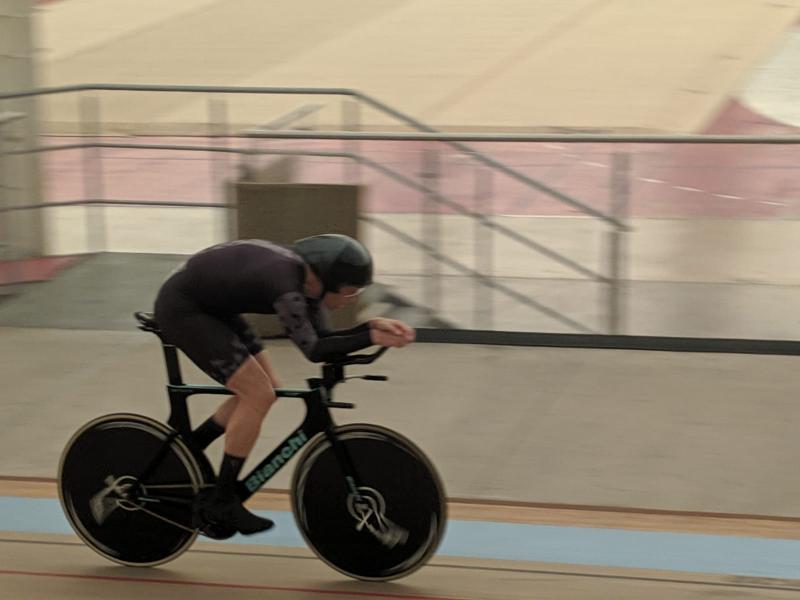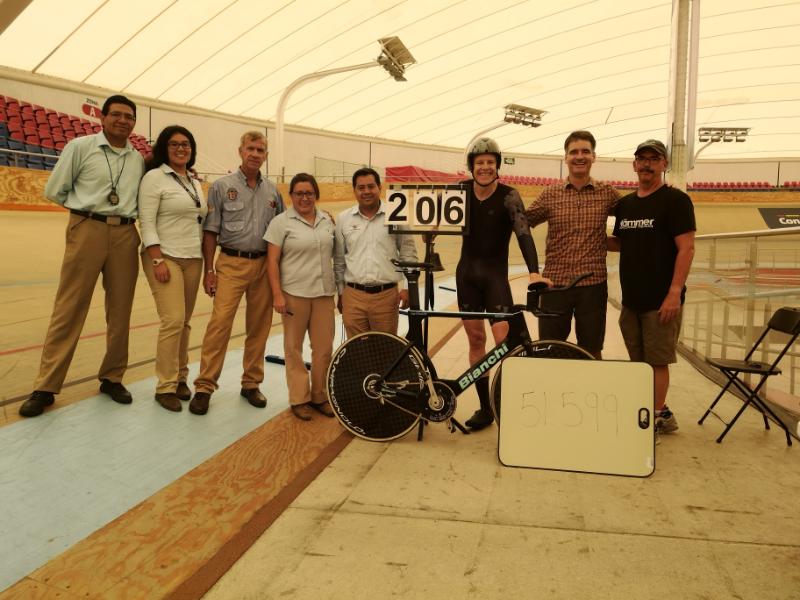Dean Works with Gert Fouche in Masters Hour Record Attempt
There’s tremendous gratification in working with a wide range of athletes from brand new recreational cyclists to champion Ironman triathletes. This is one of my favorite parts of what I do. However, every once in a while, I get a different opportunity and that is what happened when working with Gert Fouche – one of the best Masters cyclists in the world – in his attempt at the Hour Record.
I first saw Gert Fouche race at Masters Track Worlds in 2016 in Manchester England. He put up a time in the 3k pursuit that made me feel blessed he was, and always will be, more than five years younger than me. I ran into him at the Masters Worlds in Los Angeles the following year and he thanked me for the tech articles about my Hour Record pursuit I’d written that year (see Relentless Pursuit of Cycling Aerodynamics articles). Gert piled up several masters world titles on the track, won the elite national title in the 4k pursuit, and set his sights on the Hour Record for South Africa. I started working with Gert leading up to his hour record.
Gert lives at altitude and would attempt the record at an outdoor 440m track with a slow concrete surface sitting at 5,500 feet of altitude. While calling this track “slow” is an understatement in the blazing fast track cycling world. The old road racer adage of “Train heavy, race light” came to mind, Gert’s training track was definitely “training heavy”. We reviewed the final details of his familiar Cervelo T4 and Zipp 808/Disc setup, and he blazed that track to a new South Africa Hour record of 47km.
Gert then set his sights on the Masters World Hour Record for his 35-39 age group. Masters Hour Records have seen a spike in attention in recent years as many are held by ex-pro riders. We knew Gert’s power and CdA (aerodynamic drag coefficient) and thus we could compare data between him and myself on the same day tracks we shared in Manchester and LA. Based on what I was seeing, it was quite clear Gert would go very fast at the record setting velodrome in Aguascalientes, Mexico. I helped put Gert in touch with the Rob Van Houweling, who organized the trip that I set my record in 2017, and he made plans for his Mexico attempt.
Gert would need to rider farther than 49.5km to break the world record. While that sounds almost impossibly farther than his 47km mark in South Africa, this track is faster in every regard. The smooth wooden surface allows tires to roll faster than his outdoor concrete track, and of course both the 6,200 feet of altitude and hot ambient temperatures make the air resistance he faces ultra low. It only took a little calculation for me to feel that he had a very good shot at it.
However, three weeks before Gert’s attempt at the 35-39 hour record, the distance was raised to 50.5km by ex-pro Wojciech Ziolkowski from Poland*. Suddenly Gert had to set his sights even higher and the room for error was a lot less. We were confident that Gert could go 50.5km, but now there was zero room for error; Gert would need perfect execution. I’ll leave the story of what happened in the actual attempt to Gert’s recap of the day:
“An hour after my 27-hour flight to Mexico, I was on the track. I did many race pace efforts to test equipment and decide what was possible. I decided on a gear, which was a bit bigger than I initially thought I would use. At first I was thinking 60×15, then I was sure a 61×15 would be best. Then, the night before the effort, I decided to go back to the track and put on a 58×14.
On the day of the effort, I had breakfast at the hotel, I warmed up by riding my road bike to the velodrome and then I spent the 90 min before I was aiming to start making sure my Cervelo T4 was race ready and had the correct tire pressure.
 Speaking of tires, my equipment for the record attempt was as follows: Cervelo T4 (sprayed in Bianchi colours, which is always faster), Vision Metron TFA aerobars, Campagnolo Ghibli discs,Vittoria Pista speed 23c tubbies, SRM Track powermeter, 58 Ridea Chainblade, 14 EAI cog, KMC chain and ISM Attack saddle. I wore a No-Pinz Time Warp suit, No-Pinz Time Warp overshoes and a Kask Mistral helmet.
Speaking of tires, my equipment for the record attempt was as follows: Cervelo T4 (sprayed in Bianchi colours, which is always faster), Vision Metron TFA aerobars, Campagnolo Ghibli discs,Vittoria Pista speed 23c tubbies, SRM Track powermeter, 58 Ridea Chainblade, 14 EAI cog, KMC chain and ISM Attack saddle. I wore a No-Pinz Time Warp suit, No-Pinz Time Warp overshoes and a Kask Mistral helmet.
When it came to race temperature, I wanted to ride at about 23 C. However, the track was cooler than the days before – ~21 C. I therefore waited a bit before starting my 20 minute warm-up. Once I completed my warm-up, we had a live streaming video feed issue and thus I decided to wait until that was fixed; it would be great to know that my wife, family and all my supportive friends would be able to watch me.
As the start approached, I had difficulty deciding how to approach pacing. Do I ride at a speed just above the record and see what I can do the last part of the ride, or do I go out and see if I have more in the tank? I told Rob that my plan was to go out at 17.7-17.8 second per lap pace and he agreed to shout out my time every ten minutes.
The countdown began. I was relieved that all the months focus and hard work has come, but I was also nervous, very nervous, for what lay ahead. Self-doubt and performance anxiety was heavy.
The countdown timer hit 0. It was time to shine. I did a first lap of just over 24 seconds, which was about what I expected. The second lap came in at 17.1 though and started easing off as that was too fast. I went 17.3 and then 17.4. This was felt relatively easy, butit was way faster than planned. I decided to go to 17.6, but 17.3 or 17,4 just felt comfortable. Rob was initially shouting “Easy Geeert”, but he soon realized that I wasn’t going to listen (hahaha!). I decided to hold at about 17.4 for the first ten minutes and reassess.
After a very long feeling ten minutes, I went to 17.6. It felt too slow. I picked up the speed again and just rolled at the initial pace. I knew if it didn’t hurt “just right” I was going too slow. Twenty minutes came up and I was still hurting the right amount and thus I continued to hold pace. On thirty minutes the effort started to bite, but I was expecting this as the crux of the effort (between 35 and 45 minutes) approached. If you can get through 45 minutes, then you can hold on for the last 15.
On 40 minutes I started to suffer, but I held the pace. At 50 minutes I was starting to hold on; my form started folding and I was fighting. As I entered the last five minutes, Rob started shouting out the time every minute. I tried to pick up the pace but there wasn’t much left in me. At this point, I just wanted to stop. I dug deep and pushed to the finish.
I was very very glad to finish and I was super happy with the distance. My goal was to go above 50km, my dream was 51km. I went 51.6 km, which was amazing.
Looking at my file, I averaged 51.38 kmh the first 20 minutes; 51.68 kmh the second 20 minutes and 51.84 kmh in the final 20 minutes. I couldn’t have asked for more out of the pacing.
Some days you get on the bike and everything just feels right. I was lucky that this was one of those days!
Thanks Dean for all your info, input, and support!” -Gert”
 I was really happy to work with Gert in his successful hour record attempt. His experience mirrored my own. Even with so many former pro riders now entering the amateur hour record arena, by polishing out your position and technique, being careful with equipment selection and smart training, setting a world record as a true amateur can be achieved. Congratulations Gert!
I was really happy to work with Gert in his successful hour record attempt. His experience mirrored my own. Even with so many former pro riders now entering the amateur hour record arena, by polishing out your position and technique, being careful with equipment selection and smart training, setting a world record as a true amateur can be achieved. Congratulations Gert!
Contact us to reach out to Dean or one of our other experienced fitters to learn more about how we can help you maximize your performance on the bike.
*Gert wanted to make sure that we let readers know that Wojtek Wasowich never filed officially for his record attempt. Gert was made aware that the official mark to beat remained 49.5 Km prior to start. He still wanted to beat the mark Wojtek posted though and used that as his goal.
